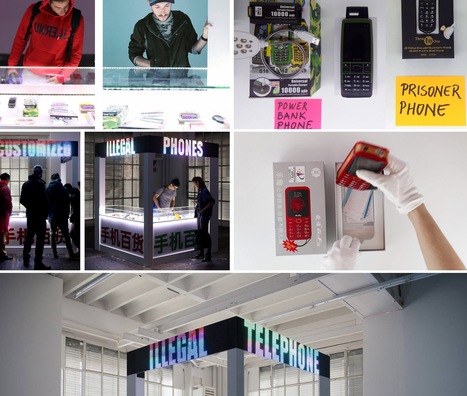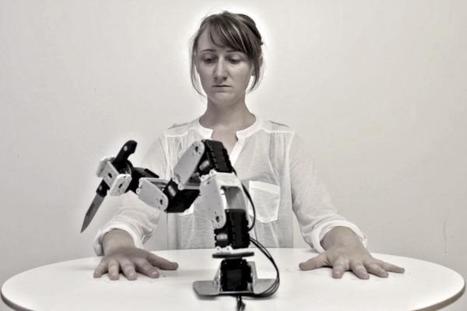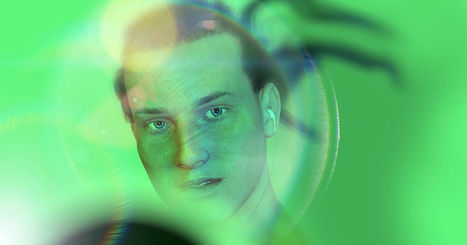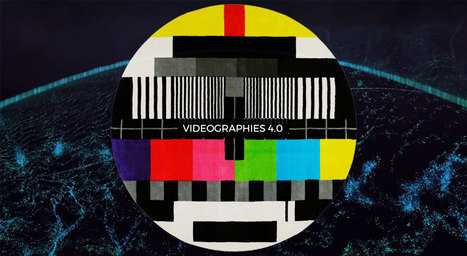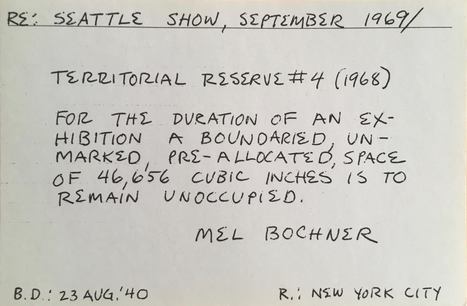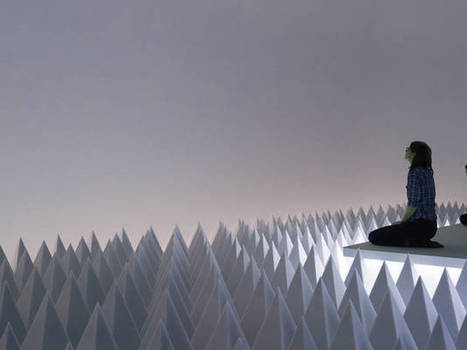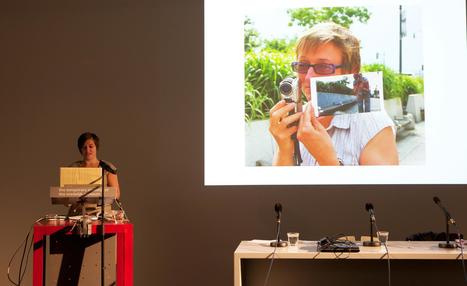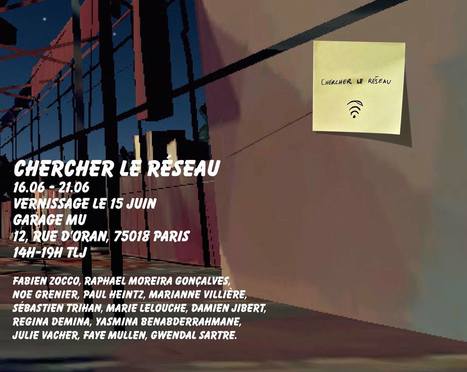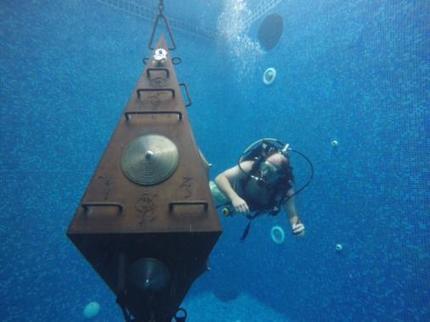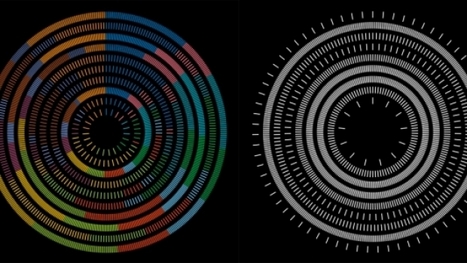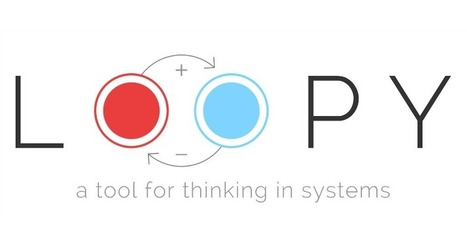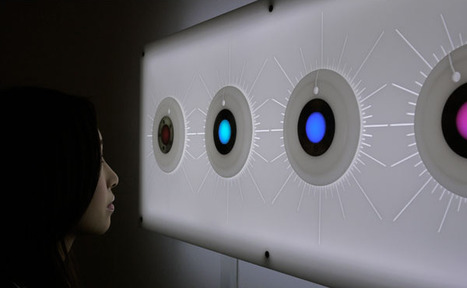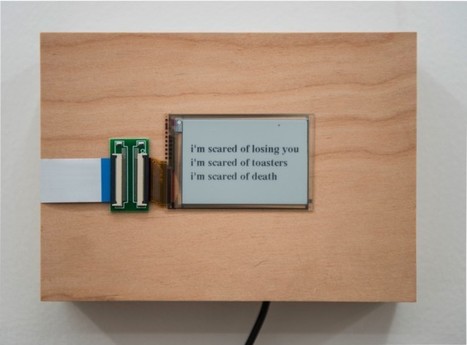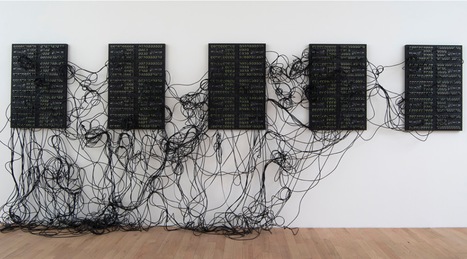Today’s vocabulary of innovation is the ultimate rhetorical tool. It inundates dominant discourse, spreading from the field of politics to the sectors of work, education and art. At the heart of this prevailing techno-positivist context, collective DISNOVATION.ORG [aka. disobedient innovation] offers a dissection of the ideology of technological innovation through a series of critical hacks.
This exhibition presents alternative narratives to the "propaganda of innovation" by exploring: a parallel history of technologies from the perspective of their failures (The Museum of Failures), the ghosts of military engineering and science fiction in everyday technologies (War Zone, Floating Prophecies), the standardization of Western technological imaginaries (Shanzhai Archeology), and an anthology on piracy of necessity (The Pirate Book).
The second part looks at the friction spaces generated between hyperconnected web users and the global network - including hacks such as: a system to predict and subvert emerging artistic trends (Predictive Art Bot), an exposure of live peer-to-peer video exchanges (The Pirate Cinema), or a printed directory containing millions of restricted addresses commonly used to filter Internet access worldwide (Blacklists).
Get Started for FREE
Sign up with Facebook Sign up with X
I don't have a Facebook or a X account

 Your new post is loading... Your new post is loading...
 Your new post is loading... Your new post is loading...
From
vimeo
An immaterial artwork consisting real fire.
Nelmarie du Preez is a South African artist based in Pretoria and London working in the fields of performance, photography, video and computational arts. In 2014 she completed her MFA Fine Art at Goldsmiths, University of London, where she also completed her MA in Computational Arts (2013).
Recently she formed part of the London Open 2015 at the Whitechapel Gallery (London), formed part of Home Works 7 at Ashkal Alwan (Beirut) and was selected for the International Digital Arts Biennale (Montreal). In the past two years she has been shortlisted for six significant international art awards and is the winner of the 2015 Sasol New Signatures. She was also selected as a 2015 Ampersand Foundation Fellow.
Du Preez is currently a lecturer in Visual Arts and New Media at the University of South Africa.
We all glow. All living cells of bacteria, plants as well as (human and non-human) animals emit biophotons, extremely weak light emissions which cannot be perceived by the naked eye and are used in cell-to-cell communication in living systems. Instruments like photomultipliers tubes (PMT), however, are such sensitive detectors of light that they can detect individual photons.
Although the transformation of the functional state of the living organism into sound was an important dimension of the work, the artists and designers were also interested in looking at the processes and authoritative gestures that legitimise the collection of personal information and how informed consent is attained and defined.
On a very warm afternoon in April, the image of a bald young white man’s head floated on a gray screen at the Kitchen, in Chelsea. The man spoke in a tone that shifted worryingly between aggressive and confessional, punctuating his lines with two disembodied hands. “And I could have been your haruspex, sexy,” he said at one point, snarling. “I could have read omens in your extricated liver.” There were pale red marks beneath his eyes, a five-o’clock shadow on his jaw.
The talking man was the creation of the British artist Ed Atkins, who purchased the avatar for five hundred dollars from a Web site called Turbosquid and brought it to life using the software program faceshift, which maps the movements of facial expressions. This is the same type of object-recognition technology that is now used by Microsoft, whose Windows Hello program lets you unlock computers by looking at them, and by apps including Snapchat, which has adopted motion capture to adorn users’ images with flower crowns or dog faces.
Videographies - VICE<->VERSA 3.0 - Arts / sciences - La Trois RTBF (00h26) - Retransmission sur RTBF Auvio
Le 25 novembre 2016, Transcultures, Centre des cultures numériques et sonores, organisait, en partenariat avec Vidéographies, Vice Versa 3.0 – Horizons numériques, un forum consacré aux liens féconds qui se nouent entre Arts et Sciences, Cultures numériques et Nouveaux médias. Cette journée de réflexion s’est tenue, dans le cadre de la Saison des cultures numériques de la Fédération Wallonie-Bruxelles, à Liège (Média Rives RTBF) et a rassemblé des experts, des chercheurs et des professionnels belges et internationaux autour de divers enjeux de la création numérique d’aujourd’hui et de demain. En parallèle, Vice Versa 3.0 a également présenté plusieurs installations (dont Olga Kisseleva, Judith Guez, Elizabeth Meur-Poniris, Claire Williams), des démos (notamment Numediart, Hovertone, Le laboratoire Mint-Université Lille 1) et des « works in progress » d’artistes et chercheurs associés ...
Avec des projets de : Alice Jarry, Anthony Rouneau, Art orienté objet, Christian Frisson, Chen Chu-Yin, Claire Williams, Drag On Slide, Edouardo Kac, Elisabeth Meur-Poniris, Fabien Zocco, Franck Soudan, François Zajéga, Gauthier Keyaerts, Curnel Gina, Heather Dewey-Hagborg, Hovertone, Jacques Urbanska, Jean-François Lahos, Judith Guez, Kika Nicolela, Larbitslab, Loic Reboursiere, Louis Philippe Demers, Marta De Menezes, Mihai Grecu & Thibault Gleize, Nicolas Bernier, Nicolas d'Alessandro, numediart, Olga Kisseleva, Paulo Dos Santos, Pauline de Chalendar, Ryoji ikeda (official), Sébastien Lacomblez, @Symbiotica (labo), @Thierry De Mey, Thomas Israel, Tom Mens, Vincent Evrard...
La programmation de cette émission a été composée par les soins de Philippe Franck, critique culturel et directeur de Transcultures qui la représente également en complicité avec Jacques Urbanska, artiste/concepteur multimédiatique et chargé des projets arts numériques pour Transcultures.
The exhibition Modus Operandi activates a well-known strategy from conceptual art using instructions and explores art by delegation. The artwork imagined by the artist is presented in form of a written or verbal statement to be executed by others. The instructions take form with advised experts such as the curator him or herself and his or her assistant, usually in dialogue with the artist. The instruction can be transmitted through: 'cards' as with the 'event scores' of the artist George Brecht or as in Lucy Lippard's 1969-74 'numbers' exhibition series ; 'Certificates' for Sol Lewitt's 'instructions' or Laurence Weiner's 'statements'; 'definitions / methods' for Claude Rutault; or in form of instructions communicated by telephone as in the mythical 'Art by Telephone' exhibition of 1969 and its recent 'Recalled' versions. Thus the artwork already exists in form of a description, and a collection of instructions makes it possible to constitute an exhibition. ...
with : Pep Agut, Ivan Argote, Robert Barry, Julien Bismuth, Mel Bochner, George Brecht, Angela Bulloch, Luis Paulo Costa, Claude Closky, Alec Debusschere, Alessandro De Francesco, Walter De Maria, Detanico Lain, Pascal Dombis, Peter Downsbrough, Mark Geffriaud, Aurélie Godard, Nicolas Knight, LAb[au], David Lamelas, Sol LeWitt, Eva & Franco Mattes, Manfred Mohr, Gianni Motti, Paulo Nazareth, Dennis Oppenheim, Casey Reas, Claude Rutault, Peter Scott, Daniel Spœrri, UBERMORGEN, Lawrence Weiner, Ian Wilson, Erwin Wurm, a.o.
A tunnel built on the whim of a Victorian inventor under the Atlantic is at last 'linking' London and New York - using a giant electronic telescope
Deep beneath the Atlantic Ocean, forgotten for the best part of a century, lies a tunnel linking London and New York. It was built on the whim of a Victorian inventor with the aim of linking two great cities and developing the kind of friendship that still exists today.
But bad fortune befell the venture - and the tunnel lay idle ever after. Until today, that is, when the project was rekindled with a modern twist.
Last year, the Solomon R. Guggenheim Museum captured the public’s attention with a working, solid gold toilet installed in one of its restrooms. This year, they're are going for something a little more subtle: A “desert” that’s acoustically soundproofed to prevent anything but the lowest of ambient sounds. PSAD Synthetic Desert III, as the installation is formally titled, is the creation of West Coast artist Doug Wheeler, who originally conceived the idea nearly 50 years ago. Working in collaboration with the museum, Wheeler is finally realizing the project after all this time.
Le NøøMuseum est une oeuvre d’art numérique immersive et interactive développée par Yann Minh depuis plus de dix ans.
C’est un musée dématérialisé de science-fiction imaginaire consacré à la préhistoire de la cyberculture, et qui étend son réseau de galeries hypermédias connectées, dans différents secteurs du cyberespace. Les premières NøøGaleries ont été installées en 2004, dans l’espace vidéoludique du jeu Unreal-Tournament sous forme de “map” personnalisées, accessibles en réseau multijoueur.
From
imal
With two decades of artistic practice exploring an understanding of the natural world through the medium of computational technologies, boredomresearch have become intimately aware of the sensitivity and vulnerability of complex systems, including those which support human life on earth.
boredomresearch have been expanding their interest in bio-inspired systems in a project Robots in Distress which considers our strategies for coping in a world increasingly destabilised by human activity. In collaboration with the Artificial Life Lab (Karl Franzens University, Graz Austria), who are employing bio-inspired robots to provide solutions operating in human polluted environments, in 2016 boredomresearch started building robots made from the same plastic waste that pollutes many marine environments. Their work with biologists and engineers offers a different perspective which challenges a broader concern over a tendency towards increasingly complex solutions to answer the challenges of environmental crisis. This has led the artists to extend cutting edge research in artificial neural networks augmented by artificial hormone production to create autonomous agents with the potential for despondency. As emotional robotics becomes a reality does it also reveal a vulnerability? As we incorporate the robustness of swarm robotics into our technological armory should we also be mindful that the most archetypal swarm of all, the honey bee, is an organism in crisis. In this presentation boredomresearch foster a new vision for technological innovation, one that recognises the fragility of the environment that sustains it.
From
vimeo
In the 19th century a lot of devices, such as Thamatrope, Phenakistiscope or Zoetrope, that displayed images were invented.
Building on research into curating new media art since 1993 at the University of Sunderland, CRUMB was founded by Beryl Graham and Sarah Cook in 2000 within the School of Arts, Design, Media and Culture, with a Small Grant from the Arts and Humanities Research Board. CRUMB's activities cover a range of practices, but are predominantly based around research, networking, and professional development for curators of new media art.
CRUMB is supported by the University of Sunderland with funding from the Arts and Humanities Research Council, The Leverhulme Trust, Arts Council England. |
|

|
Scooped by Jacques Urbanska |
Softlove relate 24h de la vie d’une femme à travers le regard avisé et éperdu de son assistant numérique. Un système intelligent connaît tout de la personne dont il a la charge exclusive, l’accompagnant à chaque instant de son quotidien. À toute heure du jour ou de la nuit, cette entité invisible et omnisciente est programmée pour anticiper ses désirs. Or, cette machine est douée d’affect et tombe secrètement amoureuse...
Publié en 2014, le texte d’Eric Sadin Softlove franchit une nouvelle étape avec cette adaptation théâtrale, ou plutôt une forme plus (con)textuelle, dans un format un peu particulier : le monologue d’une Intelligence Artificielle.

|
Scooped by Jacques Urbanska |
Rock Print is an investigation into the constructive principle of the physical phenomena of jamming, in which granular matter can change from liquid to solid and back again. Rock Print exploits this characteristic with a congruent construction system that: 1) is informed by a computational design and realised with robotic fabrication machinery, 2) can be constructed into highly differentiated and load-bearing structures at an architectural scale using low-grade bulk material, such as gravel, and 3) is fully reversible. The construction system works as follows. To be able to control where and how gravel jams, the density between the aggregates has to be decreased to a level that forces it to behave like a solid. This can be achieved by introducing tensile reinforcement, such as string, to confine the gravel. A robotic arm enables the precise placement of string according to a digital blueprint and as such informs the shape and performance of a specific architectural artefact. To reverse the construction, the string is pulled, leading to a chain reaction restoring the gravel and the string to their initial state...
Collaborators: Prof. Fabio Gramazio, Prof. Matthias Kohler, Prof. Skylar Tibbits, Andreas Thoma (project lead installation), Petrus Aejmelaeus-Lindström (project lead research), Dr. Volker Helm, Sara Falcone, Jared Laucks, Lina Kara’in, Michael Lyrenmann, Carrie McKnelly, George Varnavides, Stephane de Weck, Dr. Jan Willmann
Selected experts: Prof. Dr. Hans J. Herrmann and Dr. Falk K. Wittel (Institute for Building Materials, ETH Zurich), Prof. Dr. Heinrich Jaeger and Kieran Murphy (Chicago University)
Selected consultants: Walt + Galmarini AG
Supported by ETH Zurich, ETH Zurich Foundation Grant, MIT’s Department of Architecture, the MIT International Design Center, MIT (MISTI) Grant, Pro Helvetia Swiss Arts Council, swissnex, MISAPOR Beton AG

|
Scooped by Jacques Urbanska |
For the last 10 years, artist Ariel Guzik has searched for a way to communicate with whales and dolphins. Guzik’s project has encompassed the creation of underwater instruments, expeditions to contact whales and dolphins off the coasts of Baja California, Costa Rica and Scotland, and sound recordings of these remarkable encounters.
Guzik's Holoturian was a new work commissioned by Arts Catalyst and Edinburgh Art Festival in 2015. It was an installation of a new underwater resonance instrument, specially designed to communicate with whales and dolphins in the deep seas, and incorporated objects, drawings and films from the artist’s decade-long research project, which included a field trip by the artist and his team with Arts Catalyst to the Moray Firth in the North of Scotland to encounter the population of bottlenose dolphins that live there.

|
Scooped by Jacques Urbanska |
The structure of language – musical at its origin – is the source of this installation. Based on texts and melodies originating from operas telling the Faust myth (the epic of human curiosity and desire), the installation explores the underlying contour of language.
The work is made of industrial objects. 102 screens and speakers creating an emergent space, arranged in repetitive patterns. Blowing up the virtual into space. Phrases and melodies of the vocalists are constantly reproduced using machine learning software. Powerful algorithms, which transform the way we act and think, omnipresent in our society and in permanent interaction with us. A new version of Faust is created, fragmented and with varying degrees of legibility, recreated in light and sound movements.
It is a game with the boundaries of perception. The point where language loses its meaning and becomes abstract. Language which is pushed to its limits, where nothing is left but pure rhythmic and melodic structure. It is the organic nature of language, imitated by a machine. This reveals the proper poetics – in all its absurdity – of the digital.
A production of Le Fresnoy - Studio national des arts contemporains
lefresnoy.net
Supported by Bipolar in the framework of RUNAWAY
bipolar-production.com
Engineer: Glenn Silver
Camera: Aurelie Brouet

|
Scooped by Jacques Urbanska |
6 expériences de réalité virtuelle qui en disent long sur son potentiel - overview Kaléidoscope 2017
La réalité virtuelle est souvent associée au jeu vidéo. Pourtant, de nombreux artistes produisent des « expériences » immersives, souvent courtes, dans lequel l’utilisateur n’agit pas, ou très peu. Mardi 1er mars, une trentaine étaient présentées à la Gaîté Lyrique, à Paris, dans le cadre de Kaléidoscope. Cet événement, entièrement consacré à ce type de production, faisait une halte dans la capitale française avant de poursuivre sa tournée internationale à Tel Aviv, Stockholm, Tokyo ou encore Melbourne.
Du dessin animé à la prise de vue réelle, de la poésie à l’horreur, de l’information au clip musical : tous les possibles de la réalité virtuelle étaient présentés, offrant un aperçu alléchant des potentiels de cette technologie. Sélection.

|
Scooped by Jacques Urbanska |
The Punishment is an installation in which a robot executes a preventive punishment for its possible future disobedience. A reference to Isaac Asimov’s laws of robotics.
Technologies are now merging at high speed, notably robotics and artificial intelligence. It raises a lot of questions about man-machine relation. Tainted with dark humor, this dystopian anthropomorphization also underlines the fears that robotics engenders. How automated do we want our world, our body to be? What physical, moral and legal framework should we use? What consequences for human life? Which post-work society should we build? Isn't it time to reinvent the school? At the turn of the century, questions related to automation are popping up in everyone’s mind. We will have to answers them collectively, if possible.

|
Scooped by Jacques Urbanska |
Les données sont aujourd’hui un enjeu essentiel. En art, elles sont à la fois point de départ et matériau d'oeuvres contemporaines ainsi que de nouvelles methodologies de recherche. Nous proposons d’aborder cette question par un dialogue entre un artiste et un chercheur.
Fabien Zocco, artiste diplômé du Fresnoy en 2016, présentera sa démarche basée sur les données, et en particulier ses créations à partir de twitter et google street view.
Clarisse Bardiot reviendra sur le programme Culture Analytics qu’elle a suivi en 2016 à la UCLA (avec entre autres Lev Manovich) et les enjeux de ce nouveau champ disciplinaire pour la recherche sur l’art. ...

|
Scooped by Jacques Urbanska |
In a world filled with ever-more-complex technological, sociological, ecological, political & economic systems... a tool to make interactive simulations may not be that much help. But it can certainly try.
thanks to my generous supporters on Patreon! (see them all here)

|
Scooped by Jacques Urbanska |
James Auger and Jimmy Loizeau have been collaborating on projects since the concept of the Audio Tooth Implant was first conceived in October 2000.
[Industrial] Design is mostly concerned with the process of bringing products to market – making them desirable and therefore saleable. By removing the commercial aspect from the development of the [designed] object, it can be given a different agenda, investigating the process that gives birth to it rather than being defined by it. In this way design can comment on consumer culture; the role of products in shaping human behaviour and experience and the role of technology. It becomes a tool for questioning rather than problem solving. Through the development and dissemination of speculative and critical artefacts Auger-Loizeau aim to instigate a broader analysis of what it means to exist in a technology rich environment both today and in the near future.
Our intention is for this analysis to take place over a broad a spectrum as possible.
Auger-Loizeau projects have been published and exhibited internationally, including MoMA, New York, 21_21, Tokyo, The Science Museum, London, The National Museum of China, Beijing, and the Ars Electronica festival, Linz and are part of the permanent collection at MoMA.

|
Scooped by Jacques Urbanska |
Using 40 Raspberry Pis attached to 40 Adafruit e-ink displays, New York conceptual artist Zach Gage turned Google Search’s autocomplete function into poetry. Each “Glacier” is a unique poem generated…
The installation’s screens refresh daily as the Pis check Google for changes and update accordingly. For some search phrases, however, it’s likely that they will not be altered for years or even décades. ...

|
Scooped by Jacques Urbanska |
Data and Dragons is a series of sculptures that intercepts and logs anonymous live data captured from surrounding WiFi signals. An assembly of custom printed circuit boards and Ethernet cabling, each work is dark and austere, manifesting “the cloud”, social networks, data, leaks, and that which forms social capital into a single object. Passively interactive, the behavior of these pieces is driven by custom hardware and packet sniffers, which capture all the live data passing through the area. The information is then visualized via surface mounted LEDs, through a series of blinking patterns.
Addie Wagenknecht is an American artist based in Austria whose work explores the tension between expression and technology. Blending conceptually-driven painting, sculpture, and installation with the ethos of hacker culture, Wagenknecht constructs spaces between art object and lived experience. Here, the darker side of systems that constitute lived reality emerge, revealing alternative yet parallel realities. In the context of post-Snowden information culture, Wagenknecht’s work contemplates power, networked consciousness, and the incessant beauty of everyday life despite the anxiety of being surveilled.


